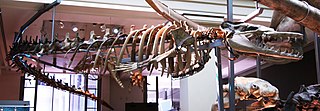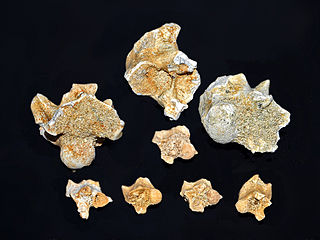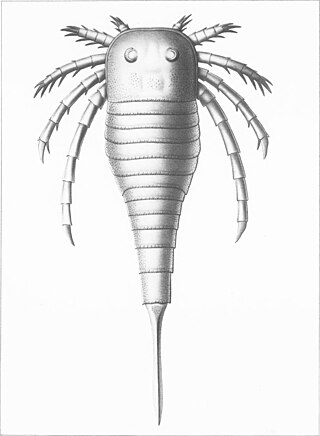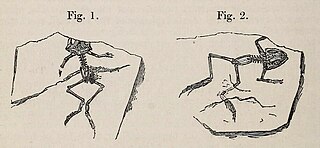
Basilosaurus is a genus of large, predatory, prehistoric archaeocete whale from the late Eocene, approximately 41.3 to 33.9 million years ago (mya). First described in 1834, it was the first archaeocete and prehistoric whale known to science. Fossils attributed to the type species B. cetoides were discovered in the United States. They were originally thought to be of a giant reptile, hence the suffix "-saurus", Ancient Greek for "lizard". The animal was later found to be an early marine mammal, which prompted attempts at renaming the creature, which failed as the rules of zoological nomenclature dictate using the original name given. Fossils were later found of the second species, B. isis, in 1904 in Egypt, Western Sahara, Morocco, Jordan, Tunisia, and Pakistan. Fossils have also been unearthed in the southeastern United States and Peru.

Dipodoidea is a superfamily of rodents, also known as dipodoids, found across the Northern Hemisphere. This superfamily includes over 50 species among the 16 genera in 3 families. They include the jerboas, jumping mice, and birch mice. Different species are found in grassland, deserts, and forests. They are all capable of saltation, a feature that is most highly evolved in the desert-dwelling jerboas.

The Mymarommatidae, sometimes referred to as false fairy wasps, are a very small family of microscopic parasitic wasps. Only about half of the known species are living taxa, but they are found worldwide.

Palaeophis is an extinct genus of marine snake that is the type genus of the extinct snake family Palaeophiidae.

Slimonia is a genus of eurypterid, an extinct group of aquatic arthropods. Fossils of Slimonia have been discovered in deposits of Silurian age in South America and Europe. Classified as part of the family Slimonidae alongside the related Salteropterus, the genus contains three valid species, S. acuminata from Lesmahagow, Scotland, S. boliviana from Cochabamba, Bolivia and S. dubia from the Pentland Hills of Scotland and one dubious species, S. stylops, from Herefordshire, England. The generic name is derived from and honors Robert Slimon, a fossil collector and surgeon from Lesmahagow.

The Alethinophidia are an infraorder of snakes that includes all snakes other than blind snakes and thread snakes. Snakes have long been grouped into families within Alethinophidia based on their morphology, especially that of their teeth. More modern phylogenetic hypotheses using genetic data support the recognition of 19 extant families, although the taxonomy of alethinophidian snakes has long been debated, and ultimately the decision whether to assign a particular clade to a particular Linnaean rank is arbitrary.

The Fur Formation is a marine geological formation of Ypresian age which crops out in the Limfjord region of northern Denmark from Silstrup via Mors and Fur to Ertebølle, and can be seen in many cliffs and quarries in the area. The Diatomite Cliffs is on the Danish list of tentative candidates for World Heritage and may become a World Heritage site. Fossils found in the Fur Formation are primarily housed at the Fossil and Mo-clay Museum on Mors Island, the Fur Museum on Fur Island, and the Natural History Museum of Denmark in Copenhagen.

Campylocephalus is a genus of eurypterid, a group of extinct aquatic arthropods. Fossils of Campylocephalus have been discovered in deposits ranging from the Carboniferous period in the Czech Republic to the Permian period of Russia. The generic name is composed of the Greek words καμπύλος (kampýlos), meaning "curved", and κεφαλή (kephalē), meaning "head".
The Ameki Formation is a Lutetian to Bartonian geological formation located in Nigeria. It belongs to the Bende-Ameki Group, which also consists of two formations namely Nanka Formation, Nsugbe Formation.

The Trionychinae are a subfamily of turtles in the family Trionychidae.

Palaeophiidae is an extinct family of marine snake within the infraorder Alethinophidia.
Micromomyidae (Micromomids) is a family of extinct plesiadapiform mammals that include some of the earliest known primates. The family includes five genera that lived from the Paleocene epoch into the early Eocene epoch.

Kokomopteroidea is an extinct superfamily of eurypterids, an extinct group of chelicerate arthropods commonly known as "sea scorpions". It is one of four superfamilies classified as part of the suborder Stylonurina. Kokomopteroids have been recovered from deposits of Early Silurian to Late Devonian age in the United States and the United Kingdom.

Syngnathoidea is a superfamily of the pipefish order Syngnathiformes. It is divided into two families, the speciose pipefish Syngnathidae, which includes the sea horses and monotypic Solenostomidae, the ghost pipefishes, which has just five species. The superfamily occurs worldwide in tropical, subtropical and temperate seas, especially in coastal waters around rock and coral reefs and among sea weed and sea grass beds. However, there are also pelagic species of pipefish and even freshwater species. In total the superfamily comprises in excess of 50 genera and nearly 300 species.

The Elapoidea are a superfamily of snakes in the clade Colubroides, traditionally comprising the families Lamprophiidae and Elapidae. Advanced genomic sequence studies, however, have found lamprophiids to be paraphyletic in respect to elapids, and anywhere between four and nine families are now recognized.
Maliamia is an extinct genus of amiid ray-finned fish from the Early Eocene, known from fragmentary remains found in the Tamaguélelt Formation of Mali. It was described in 1989, based on fossils recovered by three separate expeditions in 1975, 1979–80, and 1981. The type species is Maliamia gigas, named in reference to its large size.

Indobatrachus is an extinct genus of frog known from the Late Cretaceous (Maastrichtian) of India. It contains a single species, Indobatrachus pusillus.

Nigerophiidae is an extinct family of marine snakes known from the Late Cretaceous to the Paleogene. Species of this family were found throughout much of the former Tethys Ocean. Their taxonomic identity is uncertain due to their fragmentary remains. The earliest nigerophiid is Nubianophis from the Campanian of Sudan.
Grand Daoui is a quarry in the Ouled Abdoun Basin of Morocco known for its fossils. It is the discovery place of Phosphatherium escuilliei, the earliest known proboscidean. It was the location for several field parties between 1997 and 2001, which allowed survey of the geological and paleontological context of Phosphatherium localities. It is also rich in marine vertebrae fossils. All Phosphatherium remains to date have been found in the quarry. The discovery of fossils there has aided in the study of early African placental fauna. The marine snake Palaeophis maghrebianus is also known from the locality, as well as the primitive gavialoid Argochampsa krebsi.















